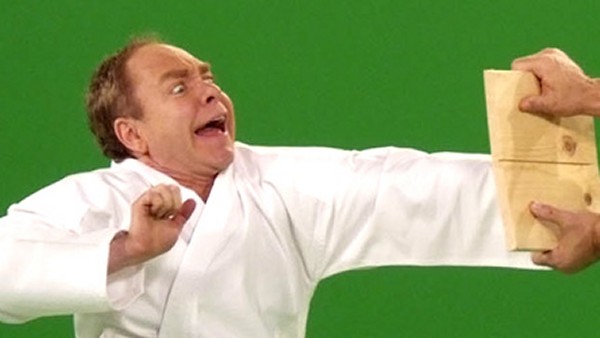Shōtōkan Karate is the most popular style in the world (80% of karate federation members practice this style in France). On an international level, the World Karate Federation (WKF) recognizes four schools of karate: Gōjū-ryū, Shitō-ryū, Shōtōkan, and Wadō-ryū. However, there are several hundreds of styles of karate, each with its own specific techniques, positions, groundwork, weapons, locks, throws, internal energy… Indeed, within the same school, different “branches” have emerged over time…

This certainly offers a wide choice to the more than 100 million karate practitioners around the world. Yet for the beginner who wishes to practice karate, this wide variety can also be somewhat destabilizing. What is the best style for my child? What is the most effective method in terms of self-defence? Which school of karate should one choose? And why not another martial art?
The quality of the teacher matters more than the style
If you have any interest in the history of martial arts and karate, you know that your “method” of karate, as you practice it today, has evolved tremendously over the last centuries. Each master played his part in this evolution, for various reasons: efficiency, morphology, personal feelings, opinions of other experts, experience of other martial arts, desire for democratization, adaptation to competition… In my opinion, no style is better than another. What matters is to benefit from a coherent, open, considered, comprehensive, adjusted, and continuously enriched teaching.
In 1756, a Chinese military officer and expert in martial arts was sent to Okinawa. He had a very strong influence on karate. His name was Kūsankū (Kwang Shang Fu). He is known for having introduced the kata Kūsankū / Kūshankū / Kosokun Dai / Kankū Dai which is practiced in many karate styles. It is even found in Taekwondo (Korean martial art derived from karate), under the name Kong-Sang-Koon. Today, this kata exists in many forms and the differences from one school to another are noteworthy. Given this kata’s particular history, imagine a closed-minded teacher believing to hold the truth about how to achieve this or that technique? Is he not merely reproducing what he has been taught, without trying to understand what is karate and its origin?
Alas, some dojos nowadays seem to remain “frozen in time”, as if no evolution is possible, for fear of deviating from the “true way”. By wanting to justify one’s distinctive style, one insists so much on its specificities, that one forgets to work on the essential aspects, or to rectify what is incorrect. For example, if you think your dojo teaches a traditional kind of karate, with an emphasis on how to defend yourself (in other words the original karate: the art of self-defence), ask yourself this simple question: do you practice defences against the most frequent street attacks (hooks, grabs, thrusts, strangulation, throws to the ground, stick, knife…) in natural stances (and not in “zenkutsu dachi”)? If the answer is no, you do not practice a “traditional/original” karate, but rather a “technical/artistic” form of karate closer to leisure and sports, usually marked by the search for the perfect move. And it is of course your right to practice such a karate. As long as your professor knows it and tells you, it’s fine, but it’s not always the case.
The original karate: the art of self-defence
Effective karate techniques are prohibited in tournaments because they are too dangerous. Yet this does not mean they do not exist. In terms of each style’s effectiveness, some practitioners today feel the need to find an “original” karate whose initial aim was self-defence. They either turn to another discipline or to “new methods” created to meet this need (karate jutsu, karate defence). This is a pity, because all this already exists in the styles of karate that we practice. Others want to supplement their training with another martial art because they feel they lack technical skills (example: locks, throws, groundwork…). The fact that MMA (Mixed Martial Arts), which integrates techniques of several martial arts, has grown incredibly in recent years is no coincidence. You may not be aware of it, but in their time, the great karate masters had already done the work of integrating different martial practices.
Indeed, the vast majority of them have practiced several martial arts and styles, with a high level of mastery. They incorporated into “their karate” the techniques they deemed relevant and effective, constantly seeking to improve their art of self-defence. Judge for yourself:
- Chatan Yara (1668 – 1756) / Tode or Te : Chinese Kempo, Bō, Saï
- Kūsankū (1670 – 1762) / Ch’uan Fa or Quan Fa : Kempo, Kumiai jutsu
- Takahara Peichin (1683 – 1760) / Okinawa-Te : Jigen Ryu, Hsin-I Quan, Saï
- Kanga Sakugawa (1733 – 1815) / Okinawa-Te : Tode, Quan-fa / Shaolin Kung Fu
- Sōkon Matsumura (1798 – 1890) / Shōrin Ryu : Tode, Ken-Jutsu, Chuan Fa
- Ankô Azato (1827 – 1906) / Shōrin Ryu : Shuri-te, Kendo, Kyudo
- Ankô Itosu (1831 – 1915) / Shōrin Ryu : Shuri-te, Chinese Boxing
- Gichin Funakoshi (1868 – 1957) / Shōtōkan Ryū : Shuri-te, Shōrin Ryu
- Kanbun Uechi (1877 – 1948) / Uechi Ryu : Chinese Shaolin Boxing
- Chōjun Miyagi (1888 – 1953) / Gōjū Ryu : Naha-te, Chinese Boxing
- Kenwa Mabuni (1889 – 1952) / Shito Ryu : Shuri-te, Naha-te, Judo, Bo-Jutsu
- Hironori Ohtsuka (1892 – 1982) / Wadō Ryu : Ju-Jutsu, Shōtōkan-ryū, Kendo
- Shigeru Egami (1912 – 1981) / Shōtōkai : Shōtōkan, Judo, Kendo, Aïkido
- Masatoshi Nakayama (1913 – 1987) / Shōtōkan : Kendo, Judo, Tai Chi Chuan
- Masutatsu Oyama (1923 – 1994) / Kyokushin : Kung Fu, Shōtōkan, Gōjū Ryu
- Hidetaka Nishiyama (1928 – 2008) / Shōtōkan : Kendo, Judo
- Taiji Kase (1929 – 2004) / Shōtōkan-ryū : Aïkido, Judo, Kendo
- Tsutomu Ohshima (1930) / Shōtōkan-ryū : Sumo, Kendo, Judo
- Hirokazu Kanazawa (1931) / Shōtōkan : Judo, English Boxing, Tai-chi, Kobudo
- Keinosuke Enoeda (1935 – 2003) / Shōtōkan-ryū : Kendo, Judo
To illustrate this, here is a short video drawing a parallel between MMA / UFC fighting techniques and their “origin” in the Okinawan karate (make your own opinion):
How can we ensure that our practice remains effective?
In order to maintain the effectiveness of “traditional” karate and to avoid restricting oneself to a single style, the key is open-mindedness. Of course, this does not necessarily mean changing your method, your dojo, your teacher, or the martial art you practice. It simply means to be constantly thinking about how to improve our practice:
- by being inquisitive, asking questions to the teacher, and researching
- by looking at what is being done in neighboring styles (for example: the differences of a kata between two schools)
- by studying techniques, tactics, exercises that seem effective in another martial art
- by adapting techniques from another martial art to your practice (though they might, in fact, already exist in your own martial art)
- by challenging the aspects that seem ineffective and by looking for ways to improve them
- by practicing your kicks and punches on more or less hard targets (rather than always practicing your moves in empty air)
- by studying some katas from other schools of karate (analysis, applications, similarities…)
- by working all applications and techniques in situations of “street fight” and self-defence
- by participating in internships with recognized and/or lesser-known experts, including experts who practice a different style from your own
- by travelling to Japan or Okinawa (or even in China) if you have the opportunity
- by practicing a “complementary” discipline, even for a few years (e.g. aikido, jujitsu, kobudo)
By being in this state of mind, your practice can only improve and you will follow a “path” closer to that of the great masters of karate. Sensei Funakoshi once said: “There is no style in karate“. If a martial art or karate style truly surpassed all the others, we would know. Just make sure that yours continues to evolve in the right direction, while showing respect and interest for those whose practice is different.
What about you? What kind of karate do you want to practice in your dojo?
Author of the article

Karate Instructor
6th Dan - BEES 2

Pingback: Is Karate Effective? (For Self Defense, Street Fights & Weight Loss) - Martial Arts Republic